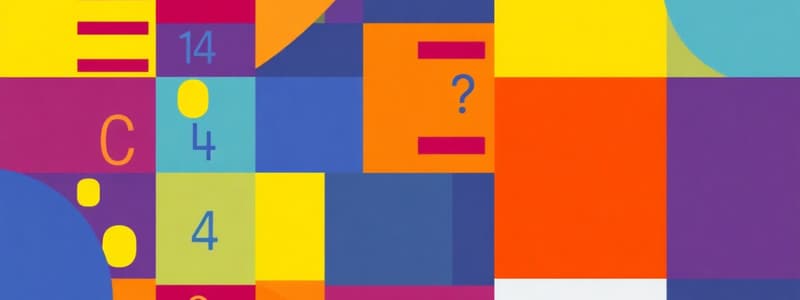Podcast
Questions and Answers
Which character encoding system is limited to representing only 128 characters?
Which character encoding system is limited to representing only 128 characters?
- Extended ASCII
- Unicode
- ASCII (correct)
- Binary Code
What type of binary representation is used for non-printing commands like 'Enter' or 'Delete'?
What type of binary representation is used for non-printing commands like 'Enter' or 'Delete'?
- Image data
- İnteger
- Float
- Character code (correct)
How many bits are used in Extended ASCII to represent characters?
How many bits are used in Extended ASCII to represent characters?
- 7 bits
- 6 bits
- 9 bits
- 8 bits (correct)
Which of the following best describes the representation of numbers in binary format?
Which of the following best describes the representation of numbers in binary format?
Which of the following can be characterized as a method for representing image data?
Which of the following can be characterized as a method for representing image data?
Flashcards
Data Representation
Data Representation
All computer data is represented using binary patterns (sequences of 1s and 0s).
Data Types
Data Types
Different forms of data, like numbers, text, images, and sound, that computers can handle.
Numbers (Data Type)
Numbers (Data Type)
Stored in binary format. Includes integers and floats.
Text (Data Type)
Text (Data Type)
Signup and view all the flashcards
Character Set
Character Set
Signup and view all the flashcards
ASCII
ASCII
Signup and view all the flashcards
Extended ASCII
Extended ASCII
Signup and view all the flashcards
Unicode
Unicode
Signup and view all the flashcards
Character Code
Character Code
Signup and view all the flashcards
Bit-pattern
Bit-pattern
Signup and view all the flashcards
Image (Data Type)
Image (Data Type)
Signup and view all the flashcards
Sound (Data Type)
Sound (Data Type)
Signup and view all the flashcards
Study Notes
Data Types/Structures
- Data types include Integer, Float, String, Char, and Boolean
- Integer, Float, and String can store multiple data structures
- An array is a special variable, holding multiple values of the same data type
Arrays
- An array stores multiple data values of the same type in a contiguous block of memory
- Accessing elements is fast, using index numbers
- Arrays have a fixed size determined at creation
- Array size limitations can cause program crashes if the array is too large
One-Dimensional Arrays (1D)
- Elements are stored linearly
- Example:
DECLARE Marks: ARRAY [1: 5] OF INTEGER
Two-Dimensional Arrays (2D)
- An array of arrays, organized as matrices (rows and columns)
- Example:
DECLARE Marks: ARRAY[1:2,1:4] OF INTEGER
Image Representation
- Black and white images use 1 bit per pixel (0 or 1)
- More bits per pixel indicate more colours available
- Colour depth determines the number of bits used to represent a pixel's colour.
- Colour depth can range from 1 bit to 24 bits, affecting colour capabilities
- Bitmap images are made of pixels in a grid pattern.
- Image resolution refers to the number of pixels in an image.
- Screen resolution refers to the number of pixels on a display.
Image/Graphic Structures
- Vector graphics use mathematical formulas to describe images, providing scalability
- Bitmap graphics are made up of pixels and lossy or lossless compression methods
Sound Data
- Sound waves are continuous, analog signals that need conversion to digital form (ADC)
- Sound is sampled at regular intervals, converting it to digital values (sampling rate)
- The number of bits per sample is the resolution or bit depth (e.g., 8-bit, 16-bit)
- Sound sampling rate determines the number of samples taken per second (Hz).
Data File/Packets
- Data files are broken down into packets for transfer over networks.
- Network protocols involve packet switching, which enables efficient use of network resources
Packet Switching
-Packets are small segments of large messages.
-They are independently transmitted.
-Routers determine the best paths.
-Packets arrive and reassembled in order at the destination.
-Packet switching increases efficiency and reliability.
Data Packets
- A packet contains: -Header: size, sequence, sender/receiver IP addresses -Payload: actual data -Trailer: error-checking information (CRC)
- Error checking ensures data integrity during transmission
Metadata
- Metadata describes data (e.g., file name, size, format), affecting file size
- Added metadata provides extra information and details
Compression
- Lossy compression permanently removes some data, reducing file size but slightly degrading quality
- Lossless compression retains all data, reducing file size without quality loss
Number Systems
- Binary (base 2), decimal (base 10), hexadecimal (base 16) are used in computers
- Each system uses different digits or characters for numbers
Studying That Suits You
Use AI to generate personalized quizzes and flashcards to suit your learning preferences.



